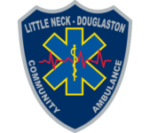Cost Recovery
Cost Recovery for the Little Neck-Douglaston Community Ambulance Corps is handled by Certified Ambulance Group (CAG). The majority of the patients we transport have a benefit or entitlement, which cover emergency ambulance transport. When using the Cost Recovery program, these third-party payers such as Medicare, Medicaid, private insurance, and auto insurance are sent statements to recover the costs of care and transportation. This money is available for every ambulance service which meets the minimum state requirements. For more information on the cost recovery program or funding, visit our funding page.
The following passage was written by Chris Gentile, the President of CAG. It goes further in-depth in explaining the reasoning for using the cost recovery program.
To Charge or Not To Charge – There Is No Question
There has been a significant amount of publicity in the recent past regarding volunteer ambulance corps. To date, no one has looked at the factual basis regarding the most appropriate manner by which these services obtain the necessary funds to provide this valuable community service. All that has been written about is the emotional side of the issue. It’s time we looked at the facts.
Prior to 1980, ambulance service, regardless of whether volunteer or proprietary, relied on the easiest method possible to raise necessary funds to sustain the operation. For the volunteer ambulance corps, this amounted to fundraising efforts. For the proprietary service, it was more convenient to send a bill for services rendered directly to the patient. Few insurance companies and even fewer governmental entitlement programs provided for payment of emergency ambulance services. But as the emergency medical system became more sophisticated and more and more third-party payers included coverage for emergency ambulance service, the way communities funded their ambulance provider began to change.
Today, the vast majority of all patients transported by emergency ambulance have a benefit or entitlement that will provide some payment for this necessary public safety/public health program. This cost of this service is covered in the premiums which are paid for the overall health package. The cost is already covered by a payment which is directly from the patient or on behalf of the patient.
Volunteer ambulance services across the country, and many in New York City, have recognized that to ask the community to pay the entire cost of ambulance service as a donation, does an injustice to the patient who has already paid for service in pavement of the premiums for the appropriate insurance. This amounts to double payment in the classic form. Service costs are covered by the benefit program, but that benefit is ignored and the full amount of the cost of services rendered is taken from the community leaving the insurance carrier with the added profit of including a benefit in the premium, but not having to pay the benefit.
Taking advantage of these other resources necessary to ensure that our volunteer ambulance services maximum the available dollars, requires a significant amount of time on the part of people who are already giving their spare time to meet the needs of the community. But these same volunteers who work feverishly to help their patients, invest the added measure so that no one member of the community is burdened above what is needed.
Insurance payments do not, and will not cover the entire cost of providing volunteer ambulance service. With limited benefits, deductibles, etc., the volunteer still needs to seek donations. The donations go to cover the cost of having the service available. There are costs in having this very expensive resource accessible, even if the ambulance does not respond to a single call. The cost of the vehicle, the training cost of the personnel, and other fixed costs go into this “cost of service availability” category. But by billing for the “cost of services rendered,” the volunteer minimizes the additional need to raise this revenue in the community.
A volunteer ambulance service which does not submit a statement of services rendered usually elects not to do so for two reasons. Either they are so entrenched in the era of the 1960’s and 1970’s that their members are not willing to make the extra effort to utilize all the financial resources at their disposal or they don’t meet the standards necessary to receive insurance and benefit plan reimbursement. In either case. a disservice is done to the community.
Finally, let’s take the emotion completely out of this argument. Some have claimed that volunteer ambulance service should be “free”. To set the record straight, volunteer ambulance service has never been free. By definition, the word “free” means without cost. There has always been a cost for providing this necessary service. Ambulance vehicles cost money; training of personnel costs money; equipment and supplies cost money; fuel and maintenance cost money – – and on and on and on. In the past, volunteer ambulance services have covered these costs through the only resource available, i.e., the community. As times have changed, the volunteer ambulance service must change with the times and take advantage of all financial resources available. We continually criticize our public officials when they don’t use our tax dollars effectively and maximize the resources available to them. We should be just as critical when our public services do the same thing.
By Chris A. Gentile – President of Certified Ambulance Group
